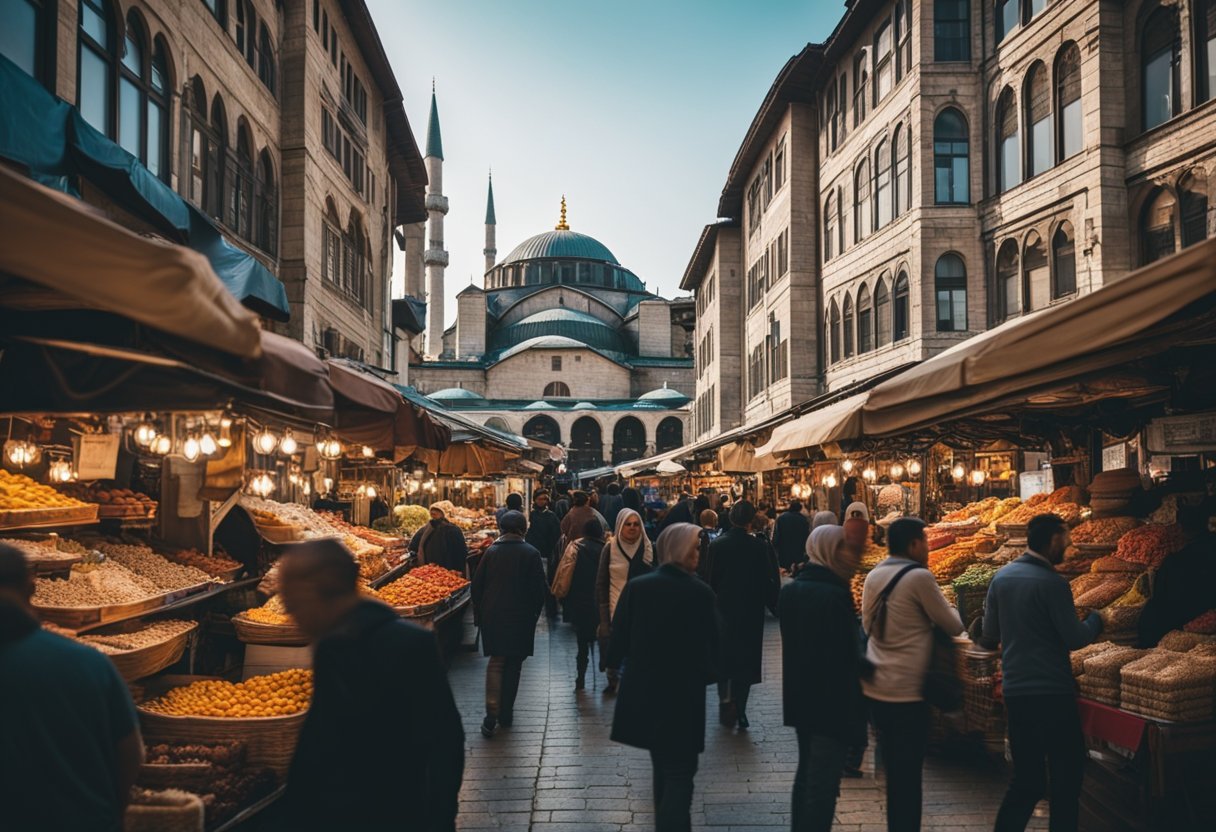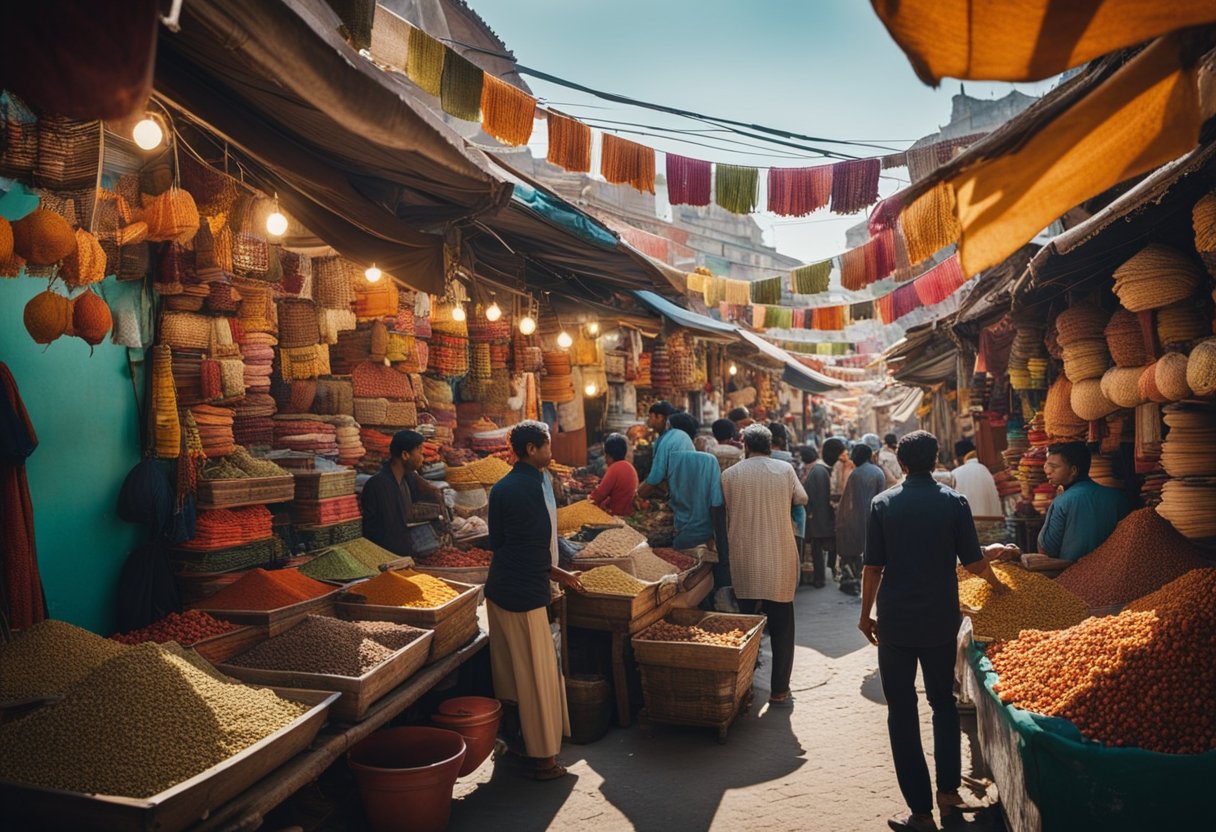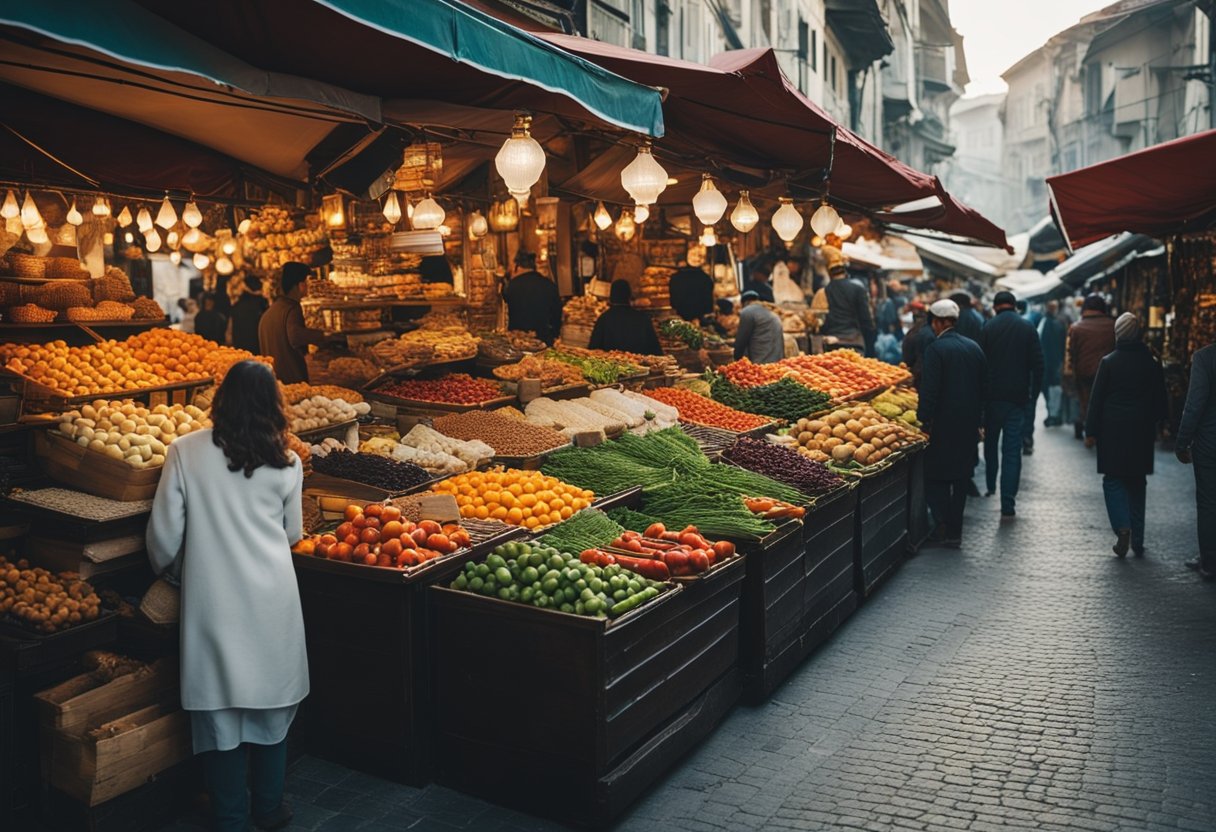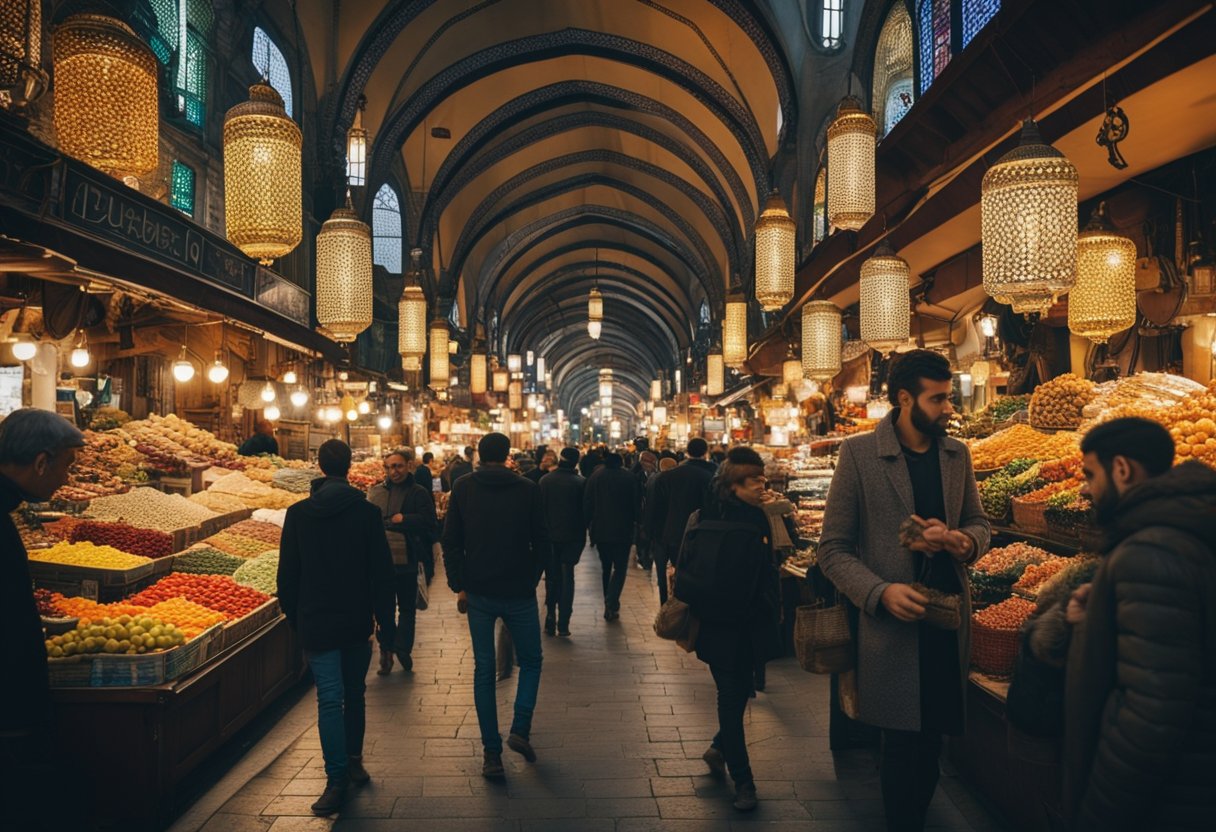The Traditional Markets of Istanbul: Explore Historic Bazaars and Hidden Gems

Updated On: April 15, 2024 by Fatma Mohamed
Travelling to Istanbul unveils a dazzling mosaic of tradition and culture intricately woven into the traditional markets of Istanbul that have served as a crossroads of civilisations for centuries. We find ourselves standing at the threshold of a world where the past and present coalesce, where every alleyway and corner bursts forth with the vibrancy of commerce and communal life. The air in these markets is thick with the scent of spices and the chatter of diverse tongues, beckoning adventurers to immerse themselves in a quintessential Istanbul shopping experience.

Amongst this rich tapestry, the Grand Bazaar holds the court as one of the largest and oldest covered markets in the world, a labyrinth of delights that promises the discovery of treasures with each visit. Meanwhile, the exuberance of the Spice Bazaar encapsulates the essence of Istanbul on every shelf, its myriad flavours and aromas a testament to the city’s historical love affair with the culinary arts. Step beyond these famed bazaars, and you encounter the pulse of local life in street markets where traditions are kept alive by artisans and merchants, each with a story to share.
Table of Contents
History of Istanbul’s Markets

Istanbul’s markets are steeped in a vibrant past, reflecting the city’s rich tapestry of history and commerce. The most illustrious of these, the Grand Bazaar or Kapalıçarşı, began in the 15th century during the rise of the Ottoman Empire. Driven by the need for a central trading space, Sultan Mehmet II fostered the creation of this marketplace following the conquest of Constantinople.
- Grand Bazaar’s Birth: Conceived in 1455-1461, it quickly became the hub for trade in the capital.
- Growth: As the empire flourished, the bazaar expanded, now housing thousands of shops across its 61 covered streets.
Meanwhile, the Egyptian Bazaar, also known as the Spice Bazaar, emerged in the 17th century. This market was named for its trade in spices and goods from Egypt and became a crucial part of the city’s commercial life.
Key Features of the Bazaars:
- Craftsmanship: These markets showcased the empire’s exquisite craftsmanship.
- Diversity: Merchants from across the empire and beyond gathered to sell a plethora of items.
- Economic significance: Up to the current day, these bazaars remain central to Istanbul’s economy.
The evolution of these marketplaces from mere points of trade to cultural and social hubs is intrinsic to our understanding of Istanbul and the Ottoman Empire. Each market, whether a major bazaar or a local corner, is a thread in the city’s historical fabric. We see the imprints of past sultans and the multitude of hands which have continually woven Istanbul’s ongoing story as a central node of global commerce.
Grand Bazaar: A Shopping Paradise
Stepping into the Grand Bazaar, visitors are immediately enveloped by the stunning display of craftsmanship and history. With over 4,000 shops, this bazaar is not just a market but a treasure trove of culture and commerce.
Architecture and Layout
The Grand Bazaar’s intricate architecture is a testament to Istanbul’s rich historical tapestry. Vaulted walkways and elaborate gates welcome patrons into its over 60 interconnected streets. The layout is designed to both entice shoppers and celebrate the splendid Ottoman architecture that has influenced markets across the world.
Variety of Goods
This market is a paradise for anyone seeking Turkish textiles, exquisite jewellery, hand-woven carpets, and finely crafted gold. Artisans and merchants offer a panoramic array of goods, each telling its own story through its craftsmanship. By visiting various shops, you’ll find that every item reflects a piece of the vibrant culture that the Grand Bazaar has cultivated for centuries.
Cultural Significance

The bazaar is not merely a place for commerce but a living museum displaying the heartbeat of Istanbul. Its role as a crucial centre for locals and travellers alike underscores its cultural significance. Every transaction is an act of participation in a tradition that artisans and shoppers have kept alive since the 15th century.
Spice Bazaar: Flavours And Aromas
Istanbul’s Spice Bazaar is a sensory feast rich with the smells and tastes of an ancient culinary tradition. Here, we unearth spices and sweets that have seasoned the city’s history.
Unique Spices and Delicacies
Within the crowded lanes of the Spice Bazaar, our senses are greeted by piles of saffron, with its deep red strands offering a taste as rich as its history. It’s a prized seasoning across the globe for its subtle earthiness and ability to elevate dishes with just a pinch. Another staple, sumac, woos us with its tart, lemony flavour — a versatile spice that perfectly complements meats and salads.
As we navigate through the market, we discover an assortment of nuts and dried fruits, a testament to the variety and abundance of Turkish produce. Stands brimming with almonds, pistachios and walnuts not only delight the palate but also recount the region’s agricultural heritage. These, alongside mountains of dried apricots and figs, showcase the natural bounty of Anatolia.
Turkish Delight and Other Confections
No stroll through the Spice Bazaar can end without indulging in Turkey’s famous Turkish delight. These soft, chewy cubes, dusted with icing sugar, come in an array of flavours, from rosewater to pomegranate, each offering a glimpse into the Ottoman’s love for sweet treats.
Beyond Turkish delight, shelves laden with baklava glisten with syrup, inviting us to taste this classic dessert of layered pastry, honey, and nuts. To complement these sweets, handcrafted tea blends, rich with aromas of the East, offer a warming sip of Turkish hospitality. Whether it’s apple, pomegranate, or the traditional black tea, each cup provides a perfect endnote to our culinary exploration.
Street Markets: Local Life and Traditions

In Istanbul, street markets are not just places to buy goods; they’re the pulsating heart of local life and traditions, offering a glimpse into the everyday routines and the rich cultural tapestry of the city.
Daily Shopping and Food Markets
We find ourselves mingling with the locals in the bustling streets where the tradition of daily shopping is alive and well. From vibrant stalls laden with fresh fruit and vegetables to the soothing aroma of brewed tea, these markets are the cornerstone of daily life. Amid calls of vendors and the exchange of pleasantries, one can witness the time-honoured practice of bargaining, a dance as old as the markets themselves.
Fish and Seafood Specialties
Our journey through Istanbul’s markets would be incomplete without savouring the fish and seafood specialities that these local bazaars are famous for. The waterfront neighbourhoods host dedicated fish markets, where the day’s catch from local fishermen is a feast for the senses. Here, seafood is celebrated, and traditions are preserved, with local artisans often seen repairing nets or tending to their boats while shoppers haggle over the freshest offerings.
Artisan and Craftsmanship
In the bustling markets of Istanbul, the intricate web of artisan craftsmanship stands as a testament to centuries-old traditions. Here, every crafted item echoes the story of Turkish heritage, meticulously handwoven into a rich cultural tapestry.
Ceramics and Kilims
Turkish ceramics, renowned for their vibrant colours and ornate patterns, are the embodiment of tradition in every curve and contour. Throughout Istanbul’s markets, ceramics crafted by skilled artisans offer a glimpse into the Ottoman art form, where each piece holds its own unique tale. We find that the essence of this craftsmanship thrives in the production of both utility and decorative pieces.
The crafting of Turkish carpets and kilims is an ancient art, where patterns are more than mere design; they are narratives woven by hand, steeped in folklore and symbolism. These textiles are prized globally for their robustness and vivid imagery, often depicting elements of nature and life.
Handmade Jewelry and Accessories

In the heart of Istanbul’s markets, we find craftsmen who have mastered the art of forming precious gold and silver into exquisite pieces of jewellery. Their expertise allows them to create both contemporary accessories and items that reflect the cultural heritage of the city. Every link and gem is infused with the spirit of Istanbul’s grandeur.
These markets are also a celebration of handmade goods, where each crafted accessory tells the story of traditional methods passed down through generations. The dedication of these artisans to their craft ensures that visitors can carry a piece of Istanbul’s soul with them.
Our journey through the markets is a voyage into the past and present, where age-old techniques meet modern hands, creating timeless treasures for us to cherish.
Bargaining in Istanbul
In Istanbul, the act of bargaining is not merely a transaction; it’s an integral part of the shopping experience, steeped in tradition and a dance of etiquette between buyer and seller.
Haggling Culture
Haggling is deeply ingrained in the fabric of Istanbul’s markets. This age-old practice is a holdover from the days of the Ottoman Empire and is particularly prevalent in historic settings such as the Grand Bazaar. Here, the bargaining process is a social ritual, a test of communication skills and patience, as much as it is about securing a purchase at a fair price. A successful negotiation depends as much on interpersonal skills as on price, with both parties aiming for a mutually satisfactory deal.
Tips for the Best Deals
When it comes to bargaining in Istanbul, a few strategies can ensure you walk away with the best deals:
- Do your research: Understand the general cost of items so you can propose fair, realistic prices.
- Start low: Politely suggest a price lower than what you’re willing to pay, leaving room for negotiation.
- Use cash: Bringing out your wallet and showing that you are ready to conclude the deal can sometimes help in sealing the bargain at your preferred price.
- Be patient and polite: A smile and a friendly attitude go a long way. Respect is key to any interaction in Istanbul’s markets.
- Walk away if needed: Be prepared to walk away if the price isn’t right. This can either result in the vendor calling you back with a better offer or helping you find the same item at another stall, potentially at a lower price.
By embracing the haggling culture and applying these tips, shoppers can fully engage with the rich heritage of Istanbul’s marketplaces.
We’re taking you through the distinct speciality markets in Istanbul, where the focus sharply turns to specific types of goods, from literary treasures to timeless antiquities.
Book Bazaar and Rare Manuscripts

The Book Bazaar, a literary haven, is where you’ll find a collection of bookshops teeming with rare manuscripts and books that span the centuries. Exquisite finds await those who seek the wisdom of the past, from Ottoman texts to contemporary works. Each stall and shop invites bibliophiles to discover unique souvenirs that tell a story.
Antiques and Vintage Finds
Traversing the lanes dedicated to antiques and vintage finds, you’ll stumble upon shops offering goods with historical significance and unparalleled charm. These corners of the market are known for their extensive assortments of treasures, from ornate jewellery to rustic homewares; every item beckons with a whisper of yesteryear. Collectors and enthusiasts searching for rare pieces will find themselves at home among these storied stands.
Food and Drinks of the Markets
Istanbul’s markets are a true feast for the senses, especially when it comes to the variety of food and drinks available. The scent of spices, the taste of artisanal sweets, and the rich tradition of Turkish beverages form an integral part of the shopping experience.
Traditional Turkish Tea and Coffee
We cannot start a conversation about Turkish markets without mentioning tea and Turkish coffee. Turkey’s tea, deep red and served in stylish tulip-shaped glasses, is a staple in the markets, often enjoyed while bargaining or taking a break. Turkish coffee, brewed in a unique pot and known for its strong, unfiltered nature, is another must-try. In many market stalls, you’ll find varieties of both beverages, often accompanied by lokum (Turkish delight) and honey-laden treats.
- Tea: Served in tulip glasses, steeped to a rich crimson hue
- Turkish Coffee: Prepared unfiltered, known for its robust taste
Street Food and Snacks
As you wander through the bustle of the bazaars, the range of street food and snacks is sure to catch your eye. From grilled corn to stuffed mussels, the markets are teeming with ready-to-eat delights. Dried fruits and nuts offer a quick, healthy snack, while sweet-toothed visitors might indulge in Turkish delight or lokum, a confection made from starch and sugar, presented in a rainbow of colours and flavours.
- Grilled Corn: Often found on open grills, a popular snack
- Lokum (Turkish Delight): Chewy, sweet cubes, often dusted with icing sugar, with varieties incorporating flavours like rosewater, lemon, and mastic
Istanbul’s markets showcase the best of traditional food and drinks, presenting an edible wonderland for visitors and locals alike. Whether you’re sipping tea, nibbling on nuts, or savouring a piece of honey-infused lokum, the flavours of Istanbul will leave a lasting impression.
Experience Beyond Shopping

In Istanbul’s bustling market scene, there’s a rich tapestry of experiences that unfold beyond the mere exchange of goods. Whether you’re looking to soak in the local culture or indulge in epicurean delights, the markets offer a gateway to the soul of the city.
Cafes and Restaurants
Strewn amongst the vibrant stalls are the cafes and restaurants serving traditional Turkish fare. Here, sipping on traditional Turkish tea is an experience in itself, as much a part of the market’s fabric as the commerce taking place. The aroma of freshly brewed tea and coffee mingles with an array of culinary treats, from savoury kebabs to sweet baklava, each offering a taste of Istanbul’s rich culinary heritage.
Historic and Cultural Tours
For those with a thirst for history, the markets are a departure point for various historic and cultural tours. Iconic tours often include the Grand Bazaar and extend to the intricate network of Istanbul’s lesser-known markets and bazaars. Visitors can embrace the city’s past with the convenience of the Istanbul E-pass, which includes guided tours to over 50 attractions. Furthermore, a Bosphorus cruise provides a unique vantage point from which to view the city’s historical skyline, bridging the Asian and European sides of Istanbul.
Local Markets of the Istanbul Boroughs
Exploring Istanbul’s boroughs reveals a rich tableau of local markets, each with its own character. From the historic centre of trade at Beyazıt to the vibrant street life of Beyoğlu, travellers can immerse themselves in the city’s living culture and commerce.
Beyazıt and Fatih
In Beyazıt, the atmosphere brims with the echo of centuries-old trade centred around the Grand Bazaar. This labyrinthine market, known as Kapalıçarşı, entices with jewellery, hand-painted ceramics, textiles, and lanterns. Nearby, Tahtakale Street is a hub for intricate handicrafts and raw materials, where local artisans procure their supplies.
Moving towards Fatih, a district steeped in history, we discover the Fatih Women’s Bazaar (Sali Pazarı), known for its assortment of textiles and household goods and teeming with local character. This area encapsulates the essence of community markets, where commerce flourishes amidst the chatter and bartering.
Beyoğlu and Local Street Bazaars
Beyoğlu’s vibrant soul is showcased through its local street bazaars. These markets act as the heartbeat of everyday life, reflecting the diverse and dynamic culture of the neighbourhood. The Beyoğlu Fish Market offers fresh catches for discerning buyers, with fishmongers proudly displaying their wares.
The Avcılar Friday Street Bazaar, situated nearby, is a kitchen-friendly market with budget-shopping options for a wide array of produce and goods. Here, residents gather to shop against a backdrop of friendly negotiation and community interaction, truly capturing the spirit of Istanbul’s bustling streets.
Frequently Asked Questions
In this section, we cover essential queries travellers frequently have regarding Istanbul’s vibrant market scene, from negotiating tips to historical insights.
What are the must-visit markets in Istanbul for authentic local experiences?
For authentic local experiences in Istanbul, visiting the Grand Bazaar and the Spice Bazaar is imperative. Both provide a plethora of traditional goods and an atmosphere rich with Turkish culture.
How does one negotiate prices in Istanbul’s traditional markets?
When visiting markets, remember that bargaining is part of the experience. Start by offering a lower price than the initial one stated, and proceed with respectful negotiation to settle at a fair price for both parties.
Can you highlight the historical significance of Istanbul’s Grand Bazaar?
The Grand Bazaar stands as one of the oldest and largest covered markets in the world, reflecting over half a millennium of trade history, dating back to the 15th century, shortly after the Ottoman conquest of Constantinople.
What cultural artefacts are unique to Istanbul’s traditional markets?
Istanbul’s markets are treasure troves of unique cultural artefacts, such as traditional Turkish rugs, hand-painted ceramics, and intricate lanterns that reflect the city’s rich artistic heritage.
Which days are the best for visiting Istanbul’s local markets?
The best time to explore Istanbul’s local markets is usually mid-week to avoid the crowds. Keep in mind that the Grand Bazaar is closed on Sundays and public holidays, so plan your visit accordingly.
How do the traditional markets of Istanbul reflect the city’s rich cultural heritage?
Istanbul’s traditional markets, like the Grand Bazaar, showcase the city’s melting pot of cultures through diverse goods, from spices and textiles to antique crafts, each telling a story of Istanbul’s historic role as a hub of commerce and culture at the crossroads of civilizations.






